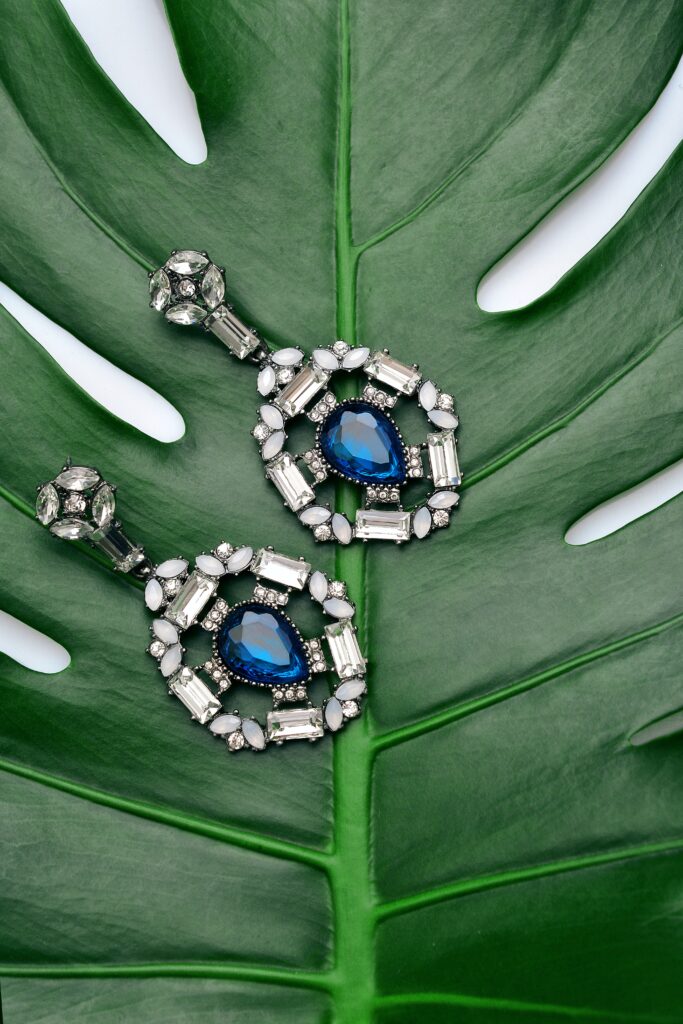
Are you in love with handmade jewelry but worry about potential skin reactions? We understand your concern. In this article, we will explore the ways you can determine if a piece of handmade jewelry is hypoallergenic. Discover helpful tips and guidance that will assist you in making informed decisions when it comes to selecting the perfect jewelry for your sensitive skin. Say goodbye to those irritating rashes and hello to stylish, hypoallergenic jewelry options. Let’s dive in and uncover the secrets to finding the perfect piece for you.

Check out our TOP three Recommended products
Check for hypoallergenic materials
When searching for hypoallergenic jewelry, it’s crucial to consider the materials used in its production. Some materials are less likely to cause allergic reactions than others, making them ideal choices for those with sensitive skin. By familiarizing yourself with common hypoallergenic materials, you can make an informed decision about which jewelry is best for you.
Research common hypoallergenic materials
There are several materials known for their hypoallergenic properties. One popular option is sterling silver, which is composed of 92.5% pure silver and 7.5% other metals, usually copper. This combination creates a strong and durable metal without compromising on style.
Another hypoallergenic material to look out for is titanium. Titanium is lightweight, corrosion-resistant, and hypoallergenic, making it an excellent choice for individuals with allergies or sensitive skin. Additionally, titanium is often used in medical implants, further solidifying its safety for those prone to reactions.
Surgical stainless steel is yet another material to consider. It is commonly used for medical instruments precisely because of its hypoallergenic properties. Jewelry made with surgical stainless steel is durable, resistant to tarnishing, and unlikely to cause allergic reactions.
Niobium is a lesser-known but equally reliable hypoallergenic material. It is frequently used in medical implants, making it a viable option for jewelry as well. With its lightweight and corrosion-resistant nature, niobium is an excellent choice for individuals seeking hypoallergenic options.
Lastly, some gold alloys are considered hypoallergenic. Commonly referred to as hypoallergenic gold alloys, these blends often contain a mix of gold, silver, and other metals. By avoiding higher nickel content in gold alloys, you can minimize the likelihood of allergic reactions.
Look for jewelry made with sterling silver
Sterling silver jewelry is a popular choice due to its versatility and affordability. It is essential, however, to ensure that the jewelry is made with genuine sterling silver. Look for markings such as “925” or “Sterling Silver” to indicate its authenticity. Additionally, reputable jewelry brands often provide certifications or guarantees verifying the quality and hypoallergenic nature of their sterling silver pieces.
Consider jewelry made with titanium
Titanium jewelry is a fantastic option for individuals with allergies or sensitive skin. Its hypoallergenic properties make it unlikely to cause adverse reactions, even with prolonged wear. Titanium jewelry is available in a variety of styles, from rings and bracelets to earrings and necklaces, allowing you to find something that matches your personal style.
Explore options with surgical stainless steel
Surgical stainless steel is an excellent choice for hypoallergenic jewelry, particularly for individuals who require durability and resistance to tarnishing. When shopping for jewelry made with surgical stainless steel, ensure that it is of high quality and free from any coatings that may contain allergens.
Try out jewelry made with niobium or titanium
Niobium and titanium are both lightweight and hypoallergenic materials, making them ideal for individuals with sensitive skin. These metals are not as prevalent as other options, but they offer unique and stylish choices for hypoallergenic jewelry. Be sure to verify that the jewelry is made with pure niobium or titanium, as some pieces may contain other metals or alloys that could cause a reaction.
Look for pieces made with hypoallergenic gold alloys
If you prefer the elegance of gold, there are hypoallergenic options available. Look for jewelry made with hypoallergenic gold alloys, which are formulated to minimize the risk of allergic reactions. Avoid gold alloys with high nickel content, as nickel is a common allergen for many individuals. By choosing hypoallergenic gold alloys, you can enjoy the beauty of gold without compromising your comfort.
Consider the craftsmanship and design
In addition to hypoallergenic materials, the craftsmanship and design of the jewelry play a significant role in determining its suitability for individuals with allergies. By paying attention to specific details, you can ensure that the jewelry you choose is not only hypoallergenic but also well-made and aesthetically pleasing.
Examine the quality of the jewelry
When evaluating jewelry for its quality, pay attention to the overall construction and finish. Look for well-crafted pieces that demonstrate attention to detail and precision. High-quality jewelry is less likely to cause skin irritations or allergic reactions, as it is less likely to contain rough edges, sharp points, or poor finishing.
Avoid pieces with sharp edges or rough surfaces
Jewelry with sharp edges or rough surfaces has the potential to irritate or even damage your skin, especially if you have allergies or sensitive skin. When examining jewelry, run your fingers along the edges and surfaces to ensure they are smooth and free from any imperfections. Smooth finishes not only enhance the comfort of wearing jewelry but also indicate superior craftsmanship.
Choose jewelry with smooth finishes
Opting for jewelry with smooth finishes is essential for individuals with sensitive skin or allergies. Smoothly polished surfaces minimize the risk of friction or irritation, allowing you to wear the jewelry comfortably for extended periods. Smooth finishes also indicate that the jewelry has been properly crafted and finished, ensuring its durability over time.
Inspect the clasps and findings
Clasps and findings are often overlooked when considering hypoallergenic jewelry. However, they play a vital role in your comfort and the overall quality of the piece. Ensure that the clasps and findings are secure, well-made, and hypoallergenic. Poorly constructed clasps can not only cause skin irritations but also risk losing your jewelry. Opt for high-quality jewelry with secure clasps to ensure both comfort and longevity.
Ensure the jewelry is well-finished and durable
Well-finished jewelry not only enhances its appearance but also reduces the risk of allergic reactions or irritations. Poor quality jewelry may contain sharp edges, rough surfaces, or uneven finishes that could harm your skin. By choosing well-finished jewelry, you can enjoy pieces that are both aesthetically pleasing and long-lasting.
Check out our TOP three Recommended products
Check for certifications or labels
In your search for hypoallergenic jewelry, certifications and labels can provide useful insight and reassurance regarding a piece’s suitability for individuals with allergies or sensitive skin. By looking for specific certifications and labels, you can gain confidence in your purchase and minimize the risk of allergic reactions.
Look for allergy-related certifications
Certain certifications highlight that a piece of jewelry has been tested and verified to be hypoallergenic. Look for certifications such as the “Certified Allergy and Skin Safe” label, which assures consumers that the jewelry has undergone rigorous testing to ensure its safety for individuals with allergies.
Seek jewelry labeled as hypoallergenic
When browsing for hypoallergenic jewelry, keep an eye out for pieces that are explicitly labeled as hypoallergenic. While such labeling is not regulated, many reputable jewelry brands take the extra step to provide this assurance, emphasizing their commitment to creating jewelry suitable for individuals with sensitive skin.
Check for nickel-free certifications
Nickel is a common allergen, causing skin irritations and allergic reactions in many individuals. If you are allergic to nickel or want to minimize the risk of a reaction, look for jewelry with nickel-free certifications. These certifications guarantee that the jewelry contains little to no nickel, making it a safe option for those prone to nickel allergies.
Test the jewelry before purchasing
Despite your best efforts to select hypoallergenic jewelry, it’s essential to test the jewelry before making a final purchase. By wearing the jewelry for a short period, observing any reactions or discomfort, and seeking professional advice, you can ensure that the jewelry is truly hypoallergenic and compatible with your skin.
Try wearing the jewelry for a short period
Before committing to a piece of jewelry, try wearing it for a short period. This practice allows your skin to come into contact with the jewelry and provides an opportunity to observe any negative reactions. Pay attention to any itching, redness, swelling, or discomfort, as these symptoms may indicate an allergic reaction.
Observe any skin reactions or discomfort
While wearing the jewelry, carefully observe your skin for any reactions or discomfort. If you experience itching, redness, irritation, or swelling, it may be a sign that the jewelry is not hypoallergenic or suitable for your skin. Take note of any symptoms and consider consulting with a healthcare professional for further advice.
Consult with a dermatologist or allergist
If you experience persistent or severe allergic reactions to jewelry, it is advisable to consult with a dermatologist or allergist. These medical professionals can provide specialized advice, conduct tests to identify specific allergens, and recommend suitable hypoallergenic materials or jewelry options for your unique needs.
Consider doing a patch test at home
To further ensure the hypoallergenic nature of the jewelry, consider conducting a patch test at home. Apply a small amount of the jewelry to an inconspicuous area of your skin and monitor it for 24 to 48 hours. If you notice any adverse reactions during this test, it is advisable to avoid purchasing or wearing that particular piece of jewelry.

Follow personal recommendations
In addition to conducting your own research, seeking personal recommendations can be a valuable resource when searching for hypoallergenic jewelry. By consulting friends, family, online communities, and customer reviews, you can gather insights and experiences that may guide you in finding the perfect hypoallergenic piece.
Ask friends or family with similar allergies
If you have friends or family members with similar allergies or sensitive skin, reach out to them for recommendations. They may have already found hypoallergenic jewelry that works well for them and can share their experiences and insights. Personal recommendations can provide a level of assurance and save you time and effort in your search.
Seek advice from online communities or forums
Online communities and forums dedicated to jewelry or allergies can be a valuable source of information. Join these communities and engage with others who have similar concerns or experiences. By asking questions and sharing your own experiences, you can benefit from the collective knowledge and help others in their search for hypoallergenic jewelry.
Read reviews from other customers
When considering a specific jewelry brand or piece, take the time to read reviews from other customers. Online platforms and websites often feature customer reviews, which provide insights into the quality, hypoallergenic properties, and overall satisfaction of the jewelry. Pay attention to recurring themes or issues mentioned in reviews to make an informed decision.
Consider the reputation of the jewelry brand
The reputation of the jewelry brand can also serve as an indicator of the quality and hypoallergenic nature of their products. Well-established brands with a history of producing hypoallergenic jewelry are likely to be more reliable and trustworthy. Look for brands that prioritize customer satisfaction, offer warranties or guarantees, and have positive feedback across various platforms.
Consult with the jewelry artisan
For those seeking unique and handmade jewelry, consulting with the jewelry artisan directly can provide valuable insights and customization options to accommodate allergies. By reaching out to the jewelry maker, you can inquire about the materials used, the artisan’s knowledge of hypoallergenic jewelry, and discuss any special requirements you may have.
Reach out to the jewelry maker
Many jewelry artisans are readily available to answer questions and provide personalized guidance. Take the opportunity to reach out to the jewelry maker or contact them through their website or social media platforms. This direct communication allows you to gauge their expertise, assess their responsiveness, and inquire about their jewelry’s hypoallergenic properties.
Ask about the materials used
When communicating with the jewelry maker, be sure to ask about the materials they use in their creations. Inquire about specific hypoallergenic materials such as sterling silver, titanium, or niobium. The jewelry maker’s knowledge and transparency regarding the materials can give you confidence in the hypoallergenic nature of the jewelry.
Inquire about their knowledge of hypoallergenic jewelry
Engage in conversations with the jewelry maker to assess their understanding and familiarity with hypoallergenic jewelry. A knowledgeable artisan should be able to discuss various hypoallergenic materials, provide recommendations, and suggest suitable options based on your specific requirements. Their expertise can be invaluable in finding the perfect piece of hypoallergenic jewelry.
Discuss customization options to accommodate allergies
If you have severe allergies or specific sensitivities, discuss customization options with the jewelry artisan. They may be able to tailor the jewelry design or the materials used to minimize the risk of allergic reactions. Customization allows you to own a piece of jewelry that is not only hypoallergenic but also uniquely suited to your style and needs.
Understand common allergens
To make informed decisions about hypoallergenic jewelry, it is crucial to familiarize yourself with common jewelry allergens. By understanding the materials or components that may cause allergic reactions, you can avoid them and increase the likelihood of finding jewelry suitable for your skin.
Familiarize yourself with common jewelry allergens
Nickel, copper, and certain metal alloys are the most common culprits for jewelry-related allergies. Nickel, in particular, is widely used in jewelry production and can cause allergic reactions, ranging from mild skin irritations to more severe allergies in susceptible individuals. By familiarizing yourself with these allergens, you can choose jewelry that minimizes the risk of adverse reactions.
Avoid jewelry containing nickel
If you have a known nickel allergy or sensitivity, it is crucial to avoid jewelry containing this metal. Look for nickel-free certifications or jewelry that explicitly states it is free from nickel. Nickel-free jewelry is more likely to be hypoallergenic and compatible with your skin.
Be cautious with copper-based jewelry
While copper has numerous desirable attributes, such as its reddish hue and malleability, it can potentially cause allergic reactions in certain individuals. If you have had allergic reactions to copper in the past, consider avoiding jewelry that contains high copper content or opt for hypoallergenic alternatives.
Stay away from alloys with high nickel content
Some metal alloys contain high levels of nickel, which can trigger allergic reactions in susceptible individuals. When shopping for hypoallergenic jewelry, avoid alloys that have a significant nickel content. Look for jewelry made with materials such as sterling silver, titanium, or niobium, which have more hypoallergenic properties.
Consider professional jewelry testing
For individuals with severe allergies or exceptional sensitivity, professional jewelry testing can provide accurate information about specific materials and their compatibility with your skin. By working with an independent jewelry appraiser or utilizing specialized testing methods, you can gain confidence in the hypoallergenic nature of the jewelry you choose.
Consult with an independent jewelry appraiser
An independent jewelry appraiser can provide expert advice and conduct thorough testing of the jewelry’s materials. They have the tools and knowledge to assess the metal composition and identify any potential allergens. By consulting with an appraiser, you can obtain precise information about the metals used and ensure you select genuinely hypoallergenic jewelry.
Request an allergy test for specific materials
To identify precisely which materials you may be allergic to, request an allergy test for specific metals or alloys. Dermatologists or allergists can perform these tests, which involve applying small amounts of various substances to your skin to observe any allergic reactions. This testing can guide you in understanding your individual allergies and avoiding any potential triggers.
Use XRF testing for accurate metal composition
XRF (X-ray fluorescence) testing is a non-destructive technique used to determine the elemental composition of metals. By using XRF equipment, you can accurately determine the metal composition of the jewelry and identify any potential allergens. This testing method provides valuable information about the jewelry’s suitability for individuals with allergies or sensitivities.
Educate yourself about allergies
To navigate the world of hypoallergenic jewelry effectively, it is crucial to educate yourself about common jewelry allergies. By understanding different types of allergies, recognizing symptoms, and differentiating between allergies and irritations, you can make informed decisions and protect your skin.
Learn about common jewelry allergies
Take the time to learn about common jewelry allergies and the symptoms they may cause. Familiarize yourself with metal allergies such as nickel, copper, or even certain gold alloys. By understanding these allergies, you can select jewelry that avoids allergenic materials and minimize the risk of allergic reactions.
Recognize symptoms of allergic reactions
Allergic reactions to jewelry can present in various ways. Symptoms commonly include itching, redness, swelling, and general skin irritation. More severe reactions may involve blisters, hives, or even difficulty breathing. By recognizing these symptoms, you can quickly identify when a piece of jewelry may be causing an allergic reaction and take appropriate action.
Understand the difference between allergies and irritations
It is essential to differentiate between true allergies and irritations when assessing your reaction to jewelry. Allergies involve an immune system response triggered by specific allergens, while irritations generally occur due to friction or contact with substances that may not be allergenic. By understanding this difference, you can narrow down the cause of the reaction and make informed decisions about suitable jewelry options.
Take precautionary measures
Even with hypoallergenic jewelry, it is essential to take precautionary measures to care for your skin and minimize the risk of reactions. By practicing proper jewelry care, you can ensure your comfort and prolong the life of your hypoallergenic pieces.
Keep jewelry clean and dry
Regularly cleaning your jewelry is essential to remove any dirt, oils, or allergens that may accumulate on the surface. Wipe your jewelry with a soft, lint-free cloth after each wear to remove any residue. Additionally, moisture can contribute to skin irritations, so ensure your jewelry remains dry and avoid wearing it when swimming or in humid environments.
Avoid exposing jewelry to harsh chemicals
Exposing your jewelry to harsh chemicals, such as cleaning agents or perfumes, can degrade its quality and potentially cause skin irritations. Remove your jewelry before engaging in activities that involve exposure to chemicals and allow any applied substances, such as perfumes or lotions, to dry completely before wearing your jewelry.
Store jewelry properly to prevent damage
Proper storage helps protect your jewelry from scratches, tarnishing, and other damages. Store your hypoallergenic pieces separately in soft pouches or jewelry boxes to prevent any contact with other objects that may cause damage. Avoid storing jewelry in humid areas or under direct sunlight, as these conditions can accelerate tarnishing.
Rotate jewelry to minimize continuous wear
Wearing the same piece of jewelry continuously can lead to skin irritations or allergies, particularly if moisture or sweat becomes trapped between the jewelry and your skin. Consider rotating your jewelry to allow your skin to breathe and prevent any potential reactions. Alternating different hypoallergenic pieces also allows you to showcase your collection and diversify your style.
In conclusion, finding hypoallergenic jewelry involves a combination of considering the materials used, assessing craftsmanship and design, checking for certifications or labels, testing the jewelry before purchasing, seeking recommendations, consulting with jewelry artisans, understanding common allergens, considering professional testing, educating yourself about allergies, and taking precautionary measures. By following these guidelines, you can select hypoallergenic jewelry that not only enhances your style but also ensures your comfort and safety. Remember to prioritize quality, research materials, and consult with professionals when necessary to make informed decisions and find the perfect hypoallergenic pieces for you.




